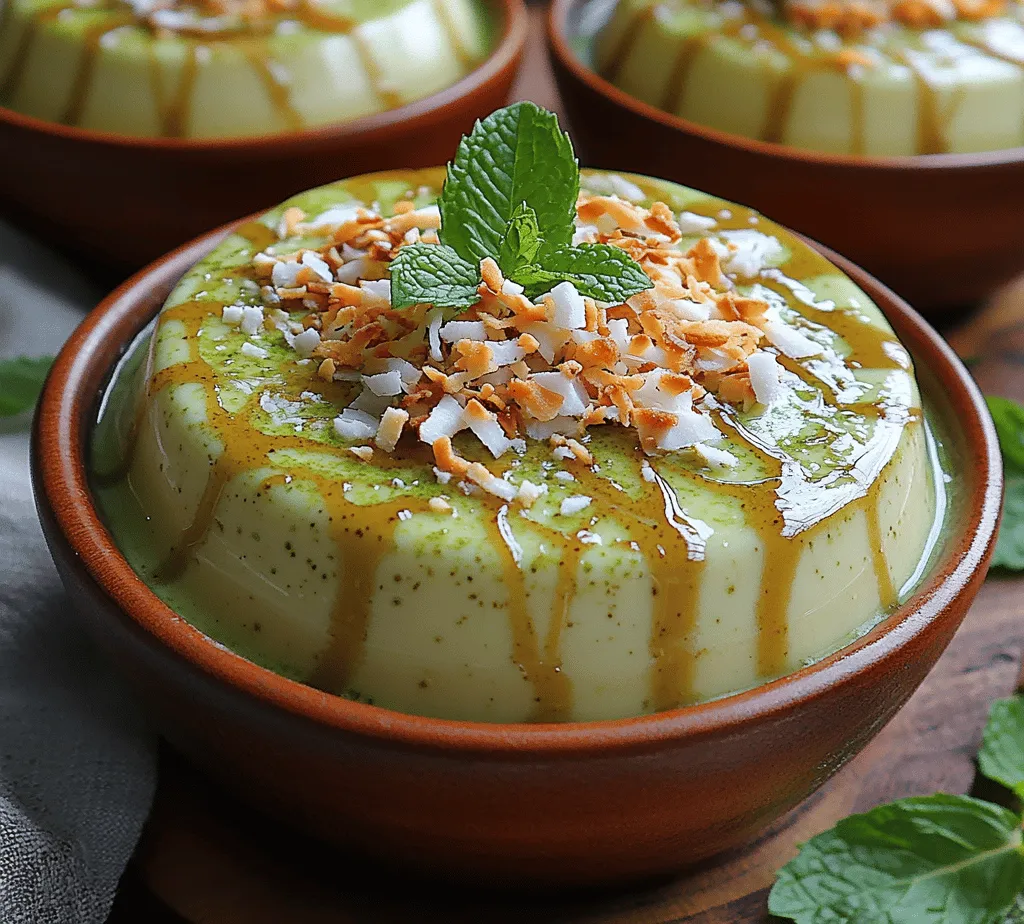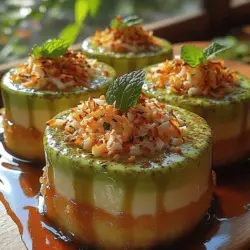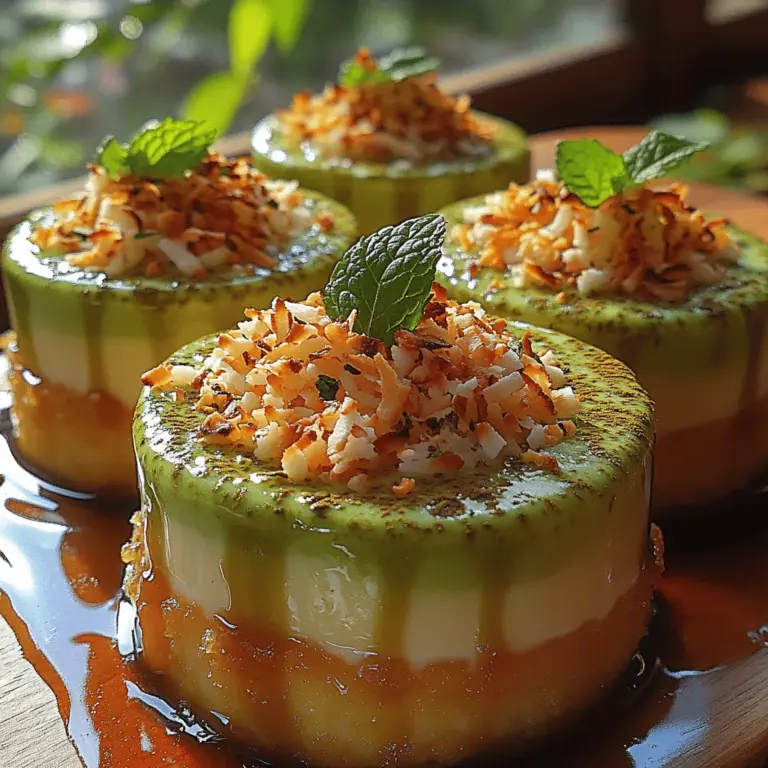Introduction
Coconut Matcha Panna Cotta is a delightful fusion of creamy texture and vibrant flavors, perfect for those seeking a refreshing dessert. This recipe marries the rich creaminess of coconut with the earthy notes of matcha, resulting in a light yet satisfying treat. The panna cotta, which translates to “cooked cream” in Italian, is a classic dessert known for its silky texture and versatility. Whether you are hosting a dinner party or simply indulging in a quiet evening at home, this panna cotta is sure to impress both your taste buds and your guests.
The allure of Coconut Matcha Panna Cotta lies not only in its unique flavor profile but also in its stunning presentation. The vibrant green hue of matcha contrasts beautifully with the creamy white coconut base, creating an eye-catching dessert that is as pleasing to the eye as it is to the palate. In this article, we will delve into the details of this exquisite dessert, from its ingredients to the step-by-step preparation, ensuring you can create this delightful dish with ease.
Understanding the Ingredients
Creating the perfect Coconut Matcha Panna Cotta starts with understanding its key components. Each ingredient plays a critical role in achieving the desired flavor, texture, and overall experience of the dessert. Let’s explore the essential ingredients that make this panna cotta a memorable treat.
Overview of Coconut Milk and Heavy Cream
Coconut milk and heavy cream form the creamy base of this panna cotta. Coconut milk, derived from the flesh of mature coconuts, provides a rich, tropical flavor and a velvety texture. It is also dairy-free, making it an excellent choice for those with lactose intolerance. Heavy cream, on the other hand, contributes to the richness and stability of the panna cotta, giving it that signature melt-in-your-mouth quality.
Nutritional Benefits and Flavor Profiles:
– Coconut Milk: Rich in medium-chain triglycerides (MCTs), coconut milk can provide a quick source of energy. It’s also packed with vitamins C, E, and B vitamins, along with minerals like magnesium and potassium.
– Heavy Cream: While higher in calories and saturated fats, heavy cream is an excellent source of vitamins A, D, E, and K. When balanced with coconut milk, it enhances the dessert’s flavor without overpowering the coconut essence.
Importance of Textures in Dessert Creation
Texture is a crucial element in dessert-making, and in panna cotta, achieving the right balance is essential. The creamy, luscious mouthfeel of the coconut milk and heavy cream is complemented by the light, airy texture that gelatin introduces. This combination results in a dessert that is both indulgent and refreshing, making it a versatile option for various occasions.
The Role of Granulated Sugar
Granulated sugar serves the dual purpose of sweetening the panna cotta while also enhancing the flavor of the other ingredients. It balances the natural richness of the coconut and the earthiness of the matcha, ensuring that no single flavor dominates the dish.
Balancing Sweetness and Enhancing Flavors:
The amount of sugar can be adjusted according to personal preference, but it’s important to find the right balance that complements the matcha without masking its unique taste. Too much sweetness can overshadow the delicate flavors, while too little may result in a bland dessert.
Matcha Green Tea Powder
Matcha is a finely ground powder made from specially grown green tea leaves, rich in antioxidants and nutrients. It has a distinct, earthy flavor that elevates the panna cotta, making it not only a delicious treat but also a health-conscious choice.
Origins and Health Benefits of Matcha:
Originating from Japan, matcha has been used in traditional tea ceremonies for centuries. It is known for its numerous health benefits, including improved metabolism, enhanced mental clarity, and increased energy levels. The vibrant green color of matcha also adds visual appeal, making it a popular ingredient in desserts and beverages alike.
How Matcha Influences Flavor and Color:
In this panna cotta, matcha provides a subtle bitterness that balances the creamy sweetness of the coconut, creating a harmonious flavor profile. The vibrant color also gives the dessert an elegant touch, making it perfect for special occasions.
Gelatin vs. Agar-Agar
When it comes to thickening agents, gelatin and agar-agar are the most commonly used options. Gelatin, derived from animal collagen, is the traditional choice for panna cotta, providing a smooth and creamy texture. Agar-agar, on the other hand, is a vegetarian alternative made from red algae, making it suitable for vegan diets.
Differences in Usage and Dietary Considerations:
– Gelatin: Typically requires blooming in cold water before being dissolved in the warm mixture. It sets firmly and creates a silky texture.
– Agar-Agar: Needs to be boiled to activate its gelling properties and sets at room temperature. It creates a firmer texture, which may not yield the same creaminess as gelatin.
Choosing the Right Thickening Agent:
When preparing Coconut Matcha Panna Cotta, consider your dietary preferences. If you’re vegan or vegetarian, agar-agar is an excellent substitute for gelatin, though the texture may vary slightly.
Sweeteners for the Matcha Drizzle
To elevate the panna cotta further, a matcha drizzle adds an extra layer of flavor and visual appeal. Sweeteners such as honey or agave syrup can be used to create this drizzle, each offering its unique taste profile.
Honey vs. Agave Syrup: Health Benefits and Flavor Differences:
– Honey: Known for its natural sweetness and health benefits, honey has antibacterial properties and can aid digestion. Its floral notes can enhance the overall flavor of the matcha drizzle.
– Agave Syrup: A plant-based sweetener with a lower glycemic index than sugar, agave syrup is a popular choice for those seeking a healthier alternative. It has a milder flavor, making it a versatile option for sweetening various dishes.
Step-by-Step Guide to Making Coconut Matcha Panna Cotta
Now that we’ve explored the ingredients, it’s time to dive into the step-by-step process of making Coconut Matcha Panna Cotta. This section will provide you with clear, concise instructions to ensure your dessert turns out perfectly every time.
Preparing the Gelatin: Blooming for Optimal Texture
The first step in making panna cotta is to prepare the gelatin. If you’re using powdered gelatin, it’s essential to bloom it properly to achieve the right texture.
Importance of Proper Blooming Technique:
Blooming gelatin involves sprinkling it over cold water and allowing it to sit for a few minutes. This process hydrates the gelatin, ensuring it dissolves evenly when heated. If you’re using agar-agar, follow the package instructions, which typically involve dissolving it in boiling water.
Heating the Coconut Mixture: Creating a Flavorful Base
Next, you’ll want to prepare the coconut milk and heavy cream mixture. In a saucepan, combine equal parts of coconut milk and heavy cream, adding the granulated sugar and a pinch of salt to enhance the flavors.
Tips for Achieving the Right Temperature Without Boiling:
Heat the mixture over medium-low heat, stirring gently until the sugar dissolves and the mixture is warm but not boiling. Avoid boiling, as this can affect the texture of the panna cotta.
Adding Matcha and Vanilla: Infusing Flavor
Once the coconut and cream mixture is warm, it’s time to infuse it with flavor. Remove the saucepan from heat and whisk in the matcha green tea powder and vanilla extract until fully combined.
This step is crucial, as it ensures the matcha is evenly distributed throughout the mixture, resulting in a beautifully flavored panna cotta.
As you continue with the preparation, remember to keep the balance of flavors and textures in mind, as they are key to the success of your Coconut Matcha Panna Cotta.
In the next section of this article, we will explore the remaining steps to complete this beautiful dessert, including setting the panna cotta and preparing the matcha drizzle. Stay tuned as we guide you through the final touches that will make your Coconut Matcha Panna Cotta a true showstopper.

Techniques for Ensuring a Smooth Blend
Creating a perfect Coconut Matcha Panna Cotta begins with mastering the blending process to achieve a smooth, creamy texture. Here are some techniques for ensuring your ingredients meld seamlessly:
1. Room Temperature Ingredients: Start by allowing your coconut milk and heavy cream to reach room temperature. Cold ingredients can prevent a smooth blend and might result in lumps.
2. Sifting the Matcha: Prior to mixing, sift the matcha powder through a fine-mesh sieve. This eliminates any clumps, promoting a lump-free mixture when combined with the liquids.
3. Whisking Method: Use a whisk to vigorously mix the coconut milk, heavy cream, and matcha together. Start slowly to combine the ingredients and then increase your speed to fully emulsify them. This technique introduces air into the mixture, which can help achieve a lighter texture.
4. Blender Option: For an ultra-smooth texture, consider using a high-speed blender. Blend the ingredients on a low setting first, then gradually increase to high until fully combined. This method is especially effective for dispersing matcha evenly throughout the mixture.
Incorporating Gelatin: Achieving the Right Consistency
Gelatin is key to achieving the desired silky texture of your panna cotta. Here’s how to incorporate it properly:
1. Blooming Gelatin: Start by blooming your gelatin in cold water. This involves sprinkling the gelatin over cold water and letting it sit for about 5-10 minutes until it swells. This step is crucial as it ensures even distribution when melted.
2. Dissolving Gelatin: After blooming, gently heat the mixture until the gelatin dissolves completely. Avoid boiling, as high temperatures can diminish gelatin’s gelling properties. Stir continuously until fully incorporated, then immediately remove from heat.
3. Combining with the Cream Mixture: Gradually whisk the gelatin mixture into the cooled coconut milk and matcha blend. It’s important to do this step slowly to avoid lumps.
Understanding the Differences in Gelatin and Agar-Agar Integration
While gelatin is a popular choice for panna cotta, agar-agar is a vegetarian alternative that requires a different approach:
1. Blooming Agar-Agar: Unlike gelatin, agar-agar must be boiled to activate its gelling properties. After blooming it in cold water, bring it to a boil while stirring constantly.
2. Setting Properties: Agar-agar sets more quickly than gelatin, often at room temperature. This means you’ll need to work swiftly to incorporate it into your mixtures.
3. Texture Differences: Panna cotta made with gelatin tends to be creamier and smoother, while agar-agar results in a firmer, more jelly-like consistency. Choose based on your preference, but keep in mind that agar-agar can alter the flavor profile slightly.
Setting the Panna Cotta: Patience is Key
Once your panna cotta mixture is fully combined, it’s time to set it. Patience is crucial in this phase:
1. Pouring into Molds: Carefully pour the mixture into your desired molds or serving dishes, leaving a little space at the top if you’re planning to add a topping later.
2. Cooling: Allow the panna cotta to cool at room temperature for about 30 minutes. This prevents condensation from forming in the refrigerator, which can alter texture.
3. Refrigeration: Cover the molds with plastic wrap and refrigerate for at least 4 hours, or ideally overnight. The longer it sets, the better the texture will be.
Crafting the Matcha Drizzle
To elevate the Coconut Matcha Panna Cotta, a matcha drizzle serves as a complementary topping. Here’s how to make it:
Mixing the Drizzle Ingredients
1. Ingredients Required: Gather matcha powder, powdered sugar, and a splash of milk (or coconut milk for a richer flavor).
2. Combining: In a small bowl, whisk together 1 tablespoon of matcha powder, 2 tablespoons of powdered sugar, and enough milk to create a drizzling consistency. Start with a small amount of milk and adjust as needed.
Achieving the Right Balance of Sweetness and Flavor
1. Taste Testing: It’s essential to taste your drizzle as you mix. Adjust the sweetness by adding more powdered sugar or balancing with additional matcha, depending on your preference.
2. Consistency Check: The drizzle should be thick enough to hold its shape but thin enough to flow easily. If it’s too thick, add a few drops of milk; if it’s too thin, incorporate more powdered sugar.
Tips for Presentation
A visually appealing dessert enhances the dining experience, so consider these presentation tips:
1. Artful Drizzling: Use a squeeze bottle or a spoon to drizzle the matcha sauce over the panna cotta artistically. Practice different patterns to find one that you love.
2. Layering Colors: Create contrast by layering the green matcha drizzle on the white panna cotta. This visual appeal makes the dessert more enticing.
Serving Suggestions and Presentation Ideas
To enhance the dining experience, consider the following serving suggestions:
Ideal Pairings with Coconut Matcha Panna Cotta
1. Fruits: Fresh fruits like sliced strawberries, mango, or kiwi add vibrant color and a refreshing tartness that complements the rich panna cotta.
2. Nuts: Toasted almonds or coconut flakes sprinkled on top provide a delightful crunch and additional flavor depth.
Suggested Beverages or Additional Desserts
1. Beverage Pairing: Serve with a light, herbal tea or a refreshing iced green tea. These beverages harmonize with the matcha flavor and cleanse the palate.
2. Additional Desserts: If you’re hosting a dinner, consider pairing the panna cotta with lighter options like fruit sorbet or a citrus tart for a well-rounded dessert table.
Garnishing Techniques
1. Fresh Mint: A sprig of mint not only adds a pop of color but also a refreshing aroma that enhances the overall experience.
2. Toasted Coconut: Sprinkle toasted coconut flakes around the panna cotta for an added crunch and to accentuate the coconut flavor.
Nutritional Benefits of Coconut Matcha Panna Cotta
Understanding the health aspects of your ingredients can make this dessert even more appealing:
Coconut Milk and Its Nutritional Profile
Coconut milk is rich in healthy fats, particularly medium-chain triglycerides (MCTs), which provide quick energy and support weight management.
Healthy Fats and Their Benefits
The healthy fats in coconut milk can aid in improving cholesterol levels and support heart health. They also promote satiety, making you feel fuller for longer.
Matcha’s Superfood Status
Matcha is renowned for its high antioxidant content, particularly catechins, which have been linked to numerous health benefits, including improved metabolism and reduced inflammation.
Antioxidant Properties and Potential Health Advantages
Incorporating matcha into your diet can help combat oxidative stress and promote overall well-being. Its unique combination of caffeine and L-theanine also promotes alertness without the jitters associated with coffee.
Balancing Indulgence with Health
While Coconut Matcha Panna Cotta is a delicious treat, its nutritious ingredients allow it to be enjoyed guilt-free. Embrace the balance of indulgence and health by savoring this dessert as part of a wholesome diet.
Conclusion
Coconut Matcha Panna Cotta is not just a dessert; it is an experience that combines tradition with modern culinary creativity. With its rich flavors and elegant presentation, this panna cotta is perfect for any occasion. By following the steps detailed in this guide, you can create a stunning and delicious treat that will surely leave a lasting impression. Enjoy the process of making this delightful dessert and the joy it brings to your table. Whether served at a special gathering or as a simple indulgence at home, this panna cotta is a testament to the beauty of combining simple ingredients into a sophisticated dish.

